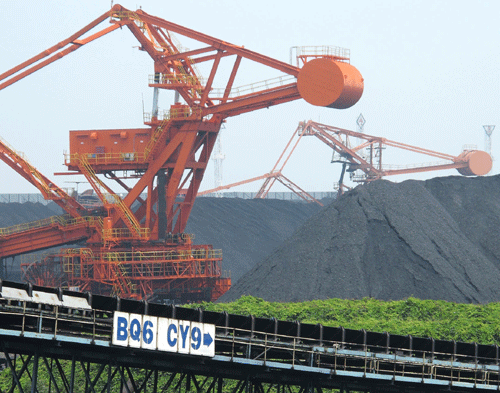Coal market 'really weak'
Updated: 2012-07-05 08:12
By Du Juan in Qinhuangdao, Hebei (China Daily)
|
||||||||
|
Mountains of coal stand idle at Qinhuangdao Port in Hebei province on Wednesday. Jiang Dong / China Daily |
Inventories pile up amid declining energy demand, growth slowdown
Black mountains of coal stand sentinel in Qinhuangdao, 300 kilometers northeast of Beijing, in what was once called the largest coal port on Earth.
They grow ever higher due to a lack of shipping orders amid a slowdown in growth since the beginning of the year.
Only five ships were present on Wednesday afternoon, in contrast with 70 to 80 ships daily during peak times.
In the port's trading center, almost deserted, the display screen was flashing out the latest cut in prices. The Bohai Bay-Rim Steam Coal Price Index showed that average prices fell to 676 yuan ($107) per ton, down 20 percent year-on-year.
"It's been like this for about two months," said the security guard, facing a blank page in the visit registration book on his desk.
The market has been "really weak" since the beginning of June, said Li Quan, a coal trader from Datong, a city in coal-rich Shanxi province in North China.
Coal stocks at the port swelled to 9.46 million tons on June 18, the highest level since the outbreak of the 2008 financial crisis, according to official statistics, close to the maximum of its designed stockpiling capacity of 10.18 million tons.
"The normal is around 6 million tons," said Xing Lei, professor at the Institute of China Coal Economy at the Central University of Finance and Economy.
Energy demand has been slowing as the economic model switches focus from exports to consumption.
Industry generally saw revenue growth average 11.9 percent year-on-year from January to May, against 27.2 percent from January to December last year, according to the National Bureau of Statistics in late June.
Wang Lifeng, general manager of Qinhuangdao Ocean Shipping Coal Trading Market, said the situation was actually getting better recently.
"The coal inventory this week is not as high as it was at the end of last month," he said. "The market is warming up a little."
Xing said most of the large electricity-generating corporations still have enough coal stocks at their power plants from last winter, so they don't need to purchase coal at present.
Dai Bing, senior analyst at coal.com.cn, a major online coal trading platform, said it will take at least two months for the market to recover.
Even if demand rebounds in August, prices will not increase as the economy will face challenges in the second half of the year, he said.
China's power consumption growth has been falling since the beginning of the year.
Electricity consumption in the first five months was 1,960 billion kilowatt-hours, up 5.8 percent year-on-year. This revealed declining growth of 6.2 points against the same period last year, according to the National Development and Reform Commission.
Energy sourced from water and coal had contrasting fortunes in May.
Hydropower generation hit 66.6 billion kilowatt-hours, up 31.1 percent year-on-year and a 52.1 percent increase on the previous month.
Coal-fired power generation in May was 301.5 billion kilowatt-hours, a 1.5 percent drop year-on-year, according to the commission.
"A major reason for high coal inventories is shrinking demand from heavy industry, construction, chemical manufacturing and steel," said Xing. "Plus, the amount of lower-priced imported coal is increasing."
China imported 112.73 million tons of coal in the first five months of the year, an increase of 67.8 percent year-on-year, according to figures from the Customs office.
Imports of thermal coal, usually used in power generation, hit 34.9 million tons, a growth rate of 183.4 percent year-on-year.
Analysts said the United States, the world's second-largest coal producer, increased its exports recently as its developed shale gas technology has reduced coal dependence.
The US exported 7.8 million tons of thermal coal to Asian markets in 2011 and looks set to easily beat that figure this year.
In March, the US exported 3.4 million tons of coal to Asia, 62 percent up on the previous month, according to figures provided by Coal.com.cn.
The US will export more than 12 million tons of coal to China in 2012, according to the US coal trader Xcoal Energy & Resources.
However, China's coal output is still increasing. In the first five months, output reached 1,561.74 million tons, 6.59 percent up year-on-year. During the same period, coal consumption was 1,489.47 million tons with 6.01 percent growth year-on-year, according to official figures.
Xing said many coal factories stopped production in June.
dujuan@chinadaily.com.cn
(China Daily 07/05/2012 page1)

 Relief reaches isolated village
Relief reaches isolated village
 Rainfall poses new threats to quake-hit region
Rainfall poses new threats to quake-hit region
 Funerals begin for Boston bombing victims
Funerals begin for Boston bombing victims
 Quake takeaway from China's Air Force
Quake takeaway from China's Air Force
 Obama celebrates young inventors at science fair
Obama celebrates young inventors at science fair
 Earth Day marked around the world
Earth Day marked around the world
 Volunteer team helping students find sense of normalcy
Volunteer team helping students find sense of normalcy
 Ethnic groups quick to join rescue efforts
Ethnic groups quick to join rescue efforts
Most Viewed
Editor's Picks

|

|

|

|

|

|
Today's Top News
Health new priority for quake zone
Xi meets US top military officer
Japan's boats driven out of Diaoyu
China mulls online shopping legislation
Bird flu death toll rises to 22
Putin appoints new ambassador to China
Japanese ships blocked from Diaoyu Islands
Inspired by Guan, more Chinese pick up golf
US Weekly

|

|







